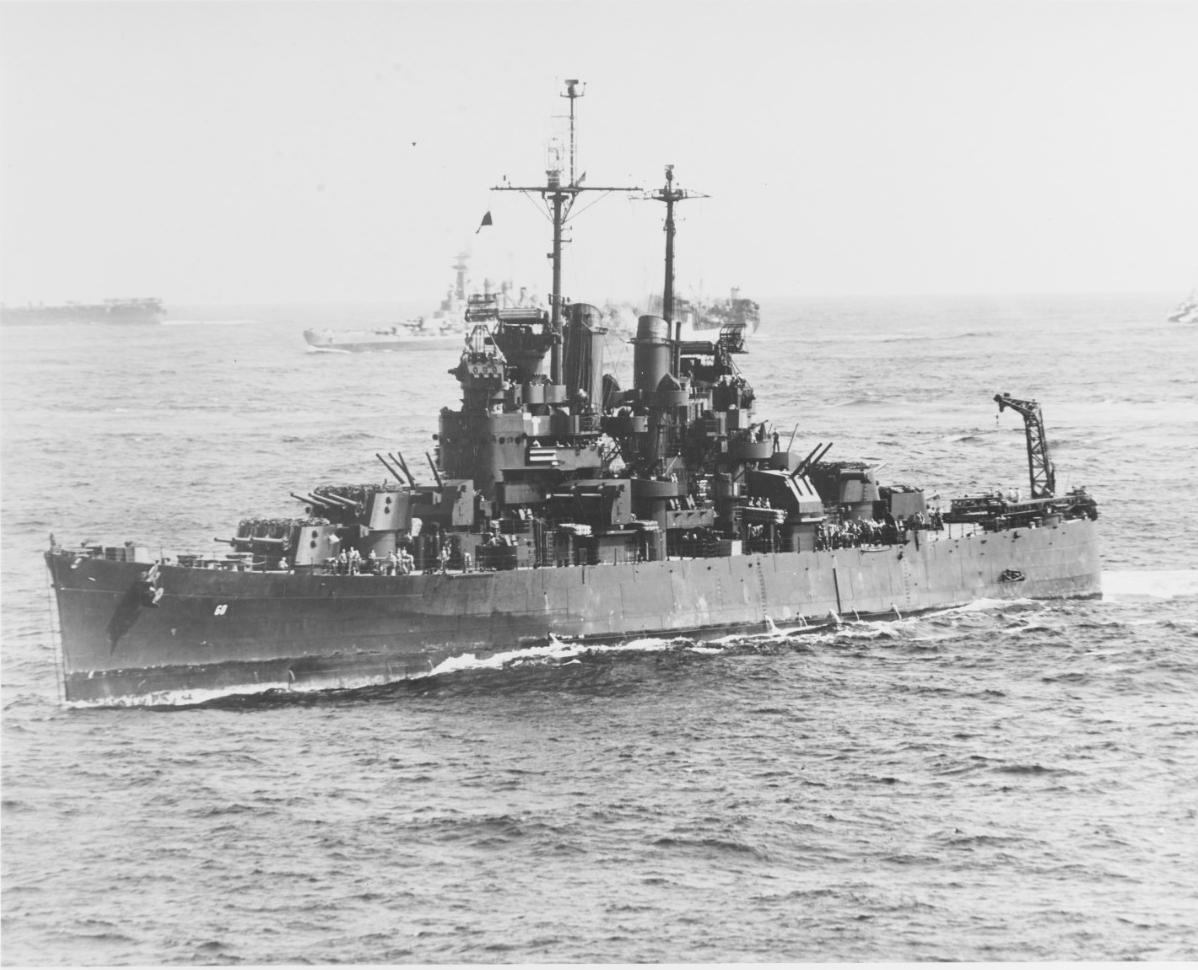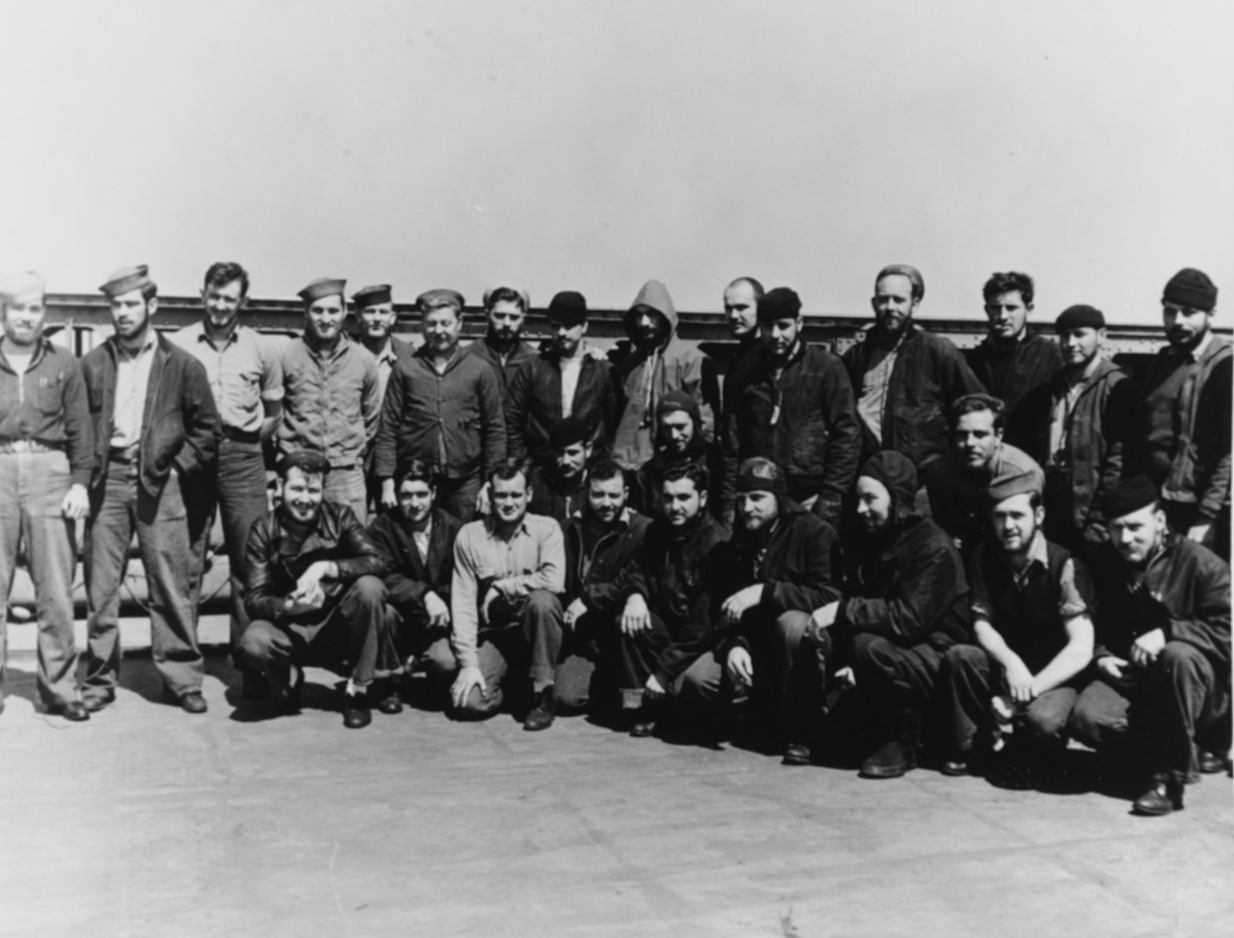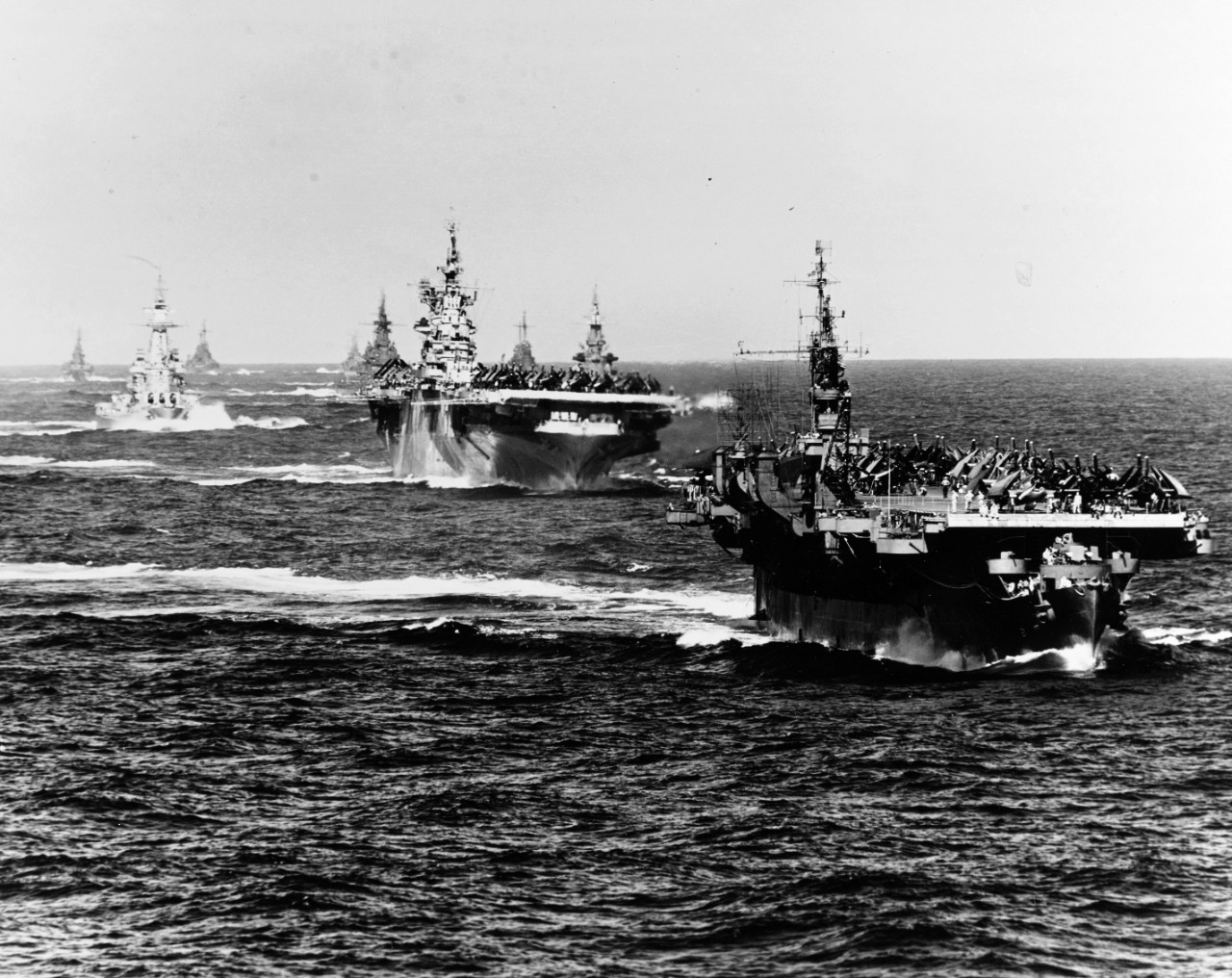Santa Fe (CL-60)
(CL-60: dp. 10,000; l. 610'1"; b. 66'4"; dr. 25'1"; s. 31.6 k.; cpl. 1,384; a. 12 6", 12 5", 16 40 mm., 14 20mm.; cl. Cleveland)
The capital of New Mexico.
Santa Fe was laid down on 7 June 1941 by New York Shipbuilding Co., Camden, N.J.; launched on 10 June 1942; sponsored by Miss Caroline T. Chavez; and commissioned on 24 November 1942, Capt. Russell Berkey in command.
After shakedown on the east coast, Santa Fe sailed for the Pacific, arriving at Pearl Harbor on 22 March 1943 en route to the Aleutians. On 26 April, six days after reaching Alaska, she bombarded Attu. The next four months were occupied primarily by patrols off the Aleutians to prevent Japanese naval operations there. This duty was varied by bombardments of Kiska on 6 and 22 July to prepare for the invasion of that island and by gunfire support for the landings there on 15 August. Santa Fe departed the Aleutians on 25 August and arrived at Pearl Harbor on 1 September.
The rest of the cruiser's war service was spent in Cruiser Division 13 with the fast carrier task forces, which spearheaded the Allied advance across the Pacific. She first escorted two carrier raids from Pearl Harbor; one against Tarawa on 18 and 19 September and one against Wake on 5 and 6 October. On the latter attack, the cruisers shelled Wake, silencing return fire from shore.
Santa Fe departed Pearl Harbor with a carrier force on 21 October, but was detached from her division to cover transports carrying reinforcements to Bougainville. She arrived on 7 November; and, for the next two days, fought off heavy enemy air attacks. After a brief period in port, she sailed from Espiritu Santo on 14 November escorting the transport force to the Gilbert Islands and, between 20 and 22 November, bombarded enemy positions on Tarawa to support the landings. On 26 November, she rejoined the fast carriers and escorted three of the mighty flattops for strikes on Kwajalein on 4 December before returning to Pearl Harbor five days later.
Late in the year, the busy cruiser returned to the United States to devote the first weeks of 1944 to amphibious training off San Pedro, Calif. She sortied on 13 January with the task force which would invade the Marshall Islands. The cruisers moved ahead of the main body on the 29th to neutralize Wotje in advance of the landings. After a morning of bombardment on 30 January, Santa Fe rejoined the main force off Kwajalein and, on 31 January and 1 February, provided gunfire support as American troops fought for that key island. She arrived at Majuro on 7 February.
Five days later, she sailed with a fast carrier force which struck the great enemy base at Truk on 16 and 17 February and hit Saipan on 22 February. She then proceeded via Majuro to Espiritu Santo. She got underway again on 15 March, escorting Enterprise and Belleau Wood as those carriers supported landings on Emirau Island on 20 March and struck Palau, Yap, and Woleai between 30 March and 1 April. On 13 April, she sortied with a task group built around carrier, Hornet, to support the invasion of Hollandia, New Guinea. Air strikes hit Wakde and Sawar on the 21st, and the surface ships bombarded the same islands the next day to neutralize them during the Hollandia landings. Released from their covering duties on 28 October, the carriers raided Truk, Satawan, and Pon-ape between 29 April and 1 May before returning to Kwajalein on the 4th.
Santa Fe sortied from the Marshalls with a group centered around carrier, Bunker Hill, and guarded her consorts during intense air strikes on Saipan, Tinian, and Guam between 11 and 16 June in support of landings on Saipan. But the Japanese fleet raced into the area to make a major effort to save the Marianas. On the morning of 19 June, swarms of Japanese carrier aircraft attacked the American 5th Fleet. Santa Fe's guns contributed to an almost impenetrable shield of flak which protected the United States carriers while American naval aviators destroyed Japan's naval air arm. Through the night and into the following day, the 5th Fleet pursued the retiring enemy warships, located them at mid-afternoon, and launched planes for a successful attack. That night, Santa Fe, ignoring possible Japanese submarines, turned on her lights to help guide the American planes back to their carriers. After strikes on Pagan Island on 24 June, Santa Fe's group entered Eniwetok for replenishment on the 27th.
Three days later, the cruiser rejoined Hornet's group; and, after morning air strikes, carried out a surface bombardment of Iwo Jima on 4 July. Between the 6th and the 21st, the carrier group alternated strikes between Guam and Rota to prevent enemy use of airfields there; and, from the 25th to the 28th, while striking Yap and Ulithi, the naval aircraft obtained invaluable photographic intelligence. After six hours at anchor off Saipan on 2 August, the force struck again at Iwo Jima on the 4th and 5th. On the 4th, the cruisers engaged a small Japanese convoy, sinking several vessels including escort Matsu; and, on the 5th, they bombarded Iwo Jima. The carrier group returned to Eniwetok on the 11th.
Between 30 August 1944 and 26 January 1945, Santa Fe operated in carrier groups centered about Essex. Their first mission was a strike on Peleliu in the Palaus from 6 to 8 September and Mindanao in the Philippines on the 9th and 10th. On the 9th, the cruisers engaged a second Japanese convoy, sinking a number of small vessels. Further air strikes in the Visayan Sea came between 12 and 14 September, and targets in the Philippines received attention from the 21st to the 24th before the task force retired to Kossol Passage in the Palaus on the 27th.
Task Group 38.3 enters Ulithi anchorage after strikes on the Philippines Islands, 12 December 1944. Langley (CVL-27), Ticonderoga (CV-14), Washington (BB-56), North Carolina (BB-55), South Dakota (BB-57), Santa Fe (CL-60), Biloxi (CL-80), Mobile (CL-63), and Oakland (CL-95). National Archives photograph, 80-G-301352.
A new series of strikes to neutralize Japanese air power during the invasion of the Philippines started with attacks on Okinawa and Formosa between 10 and 13 October. That evening, Friday the 13th, after Canberra and Houston had been damaged by torpedoes, Santa Fe, Birmingham, and Mobile were detached to help tow the damaged cruisers out of danger. On the 17th, Santa Fe rejoined the carriers for direct support to the Leyte landings.
The Essex group launched strikes on Visayan airfields on the 21st; refueled the next day; and, on the 23rd and 24th, carried out searches for Japanese naval forces reported approaching the Philippines. On the 24th, a heavy Japanese air attack was repulsed; but a single, undetected Japanese plane followed the American planes back to their carriers and put a bomb into carrier, Princeton, which later had to be sunk. Later in the afternoon, a Japanese carrier force was located to the north of Luzon, and the American carriers raced north to intercept. Early on the 25th, six battleships and seven cruisers, including Santa Fe, were sent ahead of the carriers to be ready for a gun action; and, at daybreak, the carriers began launching strikes. Late in the morning, one carrier group, with most of the battleships and cruisers, was rushed back south to intercept the Japanese Center Force, which had swept through San Bernardino Strait. But the remaining four cruisers, under the Commander of Cruiser Division 13 in Santa Fe, continued north and in mid-afternoon opened fire on Japanese cripples, sinking carrier, Chiyoda, and destroyer, Hatsuzuki, before retiring that night. Santa Fe rejoined the carriers the next day and arrived at Ulithi on 30 October after strikes on Japanese stragglers in the Visayan Sea on the 27th.
The Essex group, with Santa Fe, started for Manus for upkeep on 1 November, but was diverted to the Philippines because of a report that Japanese surface units were approaching Leyte. Although the rumor proved false, the carrier planes were nevertheless needed to cope with heavy enemy air attacks on the troops and shipping around Leyte. Friendly airfields were not yet fully ready. Santa Fe's group struck at Manila on 5 and 6 November and experienced its first Kamikaze attack on the 5th. After additional strikes on the Philippines between 11 and 14 November, the cruiser arrived at Ulithi on 17 November. Three days later, while the cruiser was replenishing in the lagoon, Japanese midget submarines got into the anchorage and torpedoed Mississinewa (AO-59). Santa Fe's float planes rescued some of the tanker's survivors.
The Essex group, with Santa Fe, got underway again on 22 November, carried out strikes on the Philippines on the 25th, and remained on station until 1 December. After another stop at Ulithi, the carrier group was again at sea supporting the Mindoro landings when a typhoon on 18 and 19 December sank three destroyers. After searching for survivors, the ships returned to Ulithi on the 24th. Back at sea on 30 December 1944, the Essex force struck Formosa and Okinawa on 3 and 4 January 1945, Luzon on the 6th and 7th, and Formosa again on the 9th, to neutralize Japanese air fields during landings on Luzon from Lingayan Gulf. The ships then entered the South China Sea, raided shipping along the Indochina coast on 12 January, and along the China coast on the 15th and 16th. Leaving the South China Sea on 20 January, the carriers struck Formosa on the 21st and Okinawa on the 22nd before returning to Ulithi on the 26th.
Santa Fe sailed with Yorktown and other units on 10 February; and, on 16 and 17 February, her group launched strikes on air fields around Tokyo to destroy aircraft that might interfere with landings on Iwo Jima. Santa Fe was detached from the carriers on the 18th, and bombarded Iwo Jima between 19 and 21 February, silencing Japanese gun batteries on Mt. Suribachi and firing illumination missions at night. She rejoined the carriers for another raid on Tokyo on the 25th and then retired to Ulithi on 1 March.
On 14 March, the cruiser joined Hancock's group, which launched strikes on Kyushu on 18 March and on Japanese fleet units at Kure and Kobe on the 19th. Just as the first strikes were being launched on the 19th, a single Japanese plane dropped two bombs into a cluster of planes on Franklin's deck, setting off immense explosions and fires. Santa Fe maneuvered alongside the carrier, and despite a hail of exploding ammunition, rescued survivors and fought fires. After the cruiser had been alongside for nearly three hours, 833 survivors had been rescued, the major fires were under control, and cruiser Pittsburgh was ready to tow the carrier. Santa Fe escorted the carrier to Ulithi; and, needing repairs herself, left Ulithi on 27 March for a trip back to the United States, escorting Franklin as far as Pearl Harbor. She received a Navy Unit Commendation for her part in the salvage of Franklin.
Overhaul at San Pedro, Cal., lasted from 10 April to 14 July. The cruiser returned to Pearl Harbor on 1 August and sailed from there on the 12th with carrier, Antietam, and cruiser, Birmingham, to attack Wake Island. The raid was cancelled when Japan capitulated on the 15th, and the ships were diverted, first to Eniwetok and then to Okinawa, anchoring in Buck-ner Bay on 26 August. Santa Fe arrived in Sasebo on 20 September; and, between 17 October and 10 November, assisted in the occupation of northern Honshu and Hokkaido. She reported for "Magic Carpet" duty on 10 November and made two trips bringing troops home from Saipan, Guam, and Truk before arriving on 25 January 1946 at Bremerton, Wash.
Santa Fe was decommissioned on 19 October 1946 and attached to the Bremerton Group, U.S. Pacific Reserve Fleet. She was struck from the Navy list on 1 March 1959 and sold on 9 November 1959 to Zidell Explorations, Inc., for scrapping.
Santa Fe received 13 battle stars for her World War II service.





